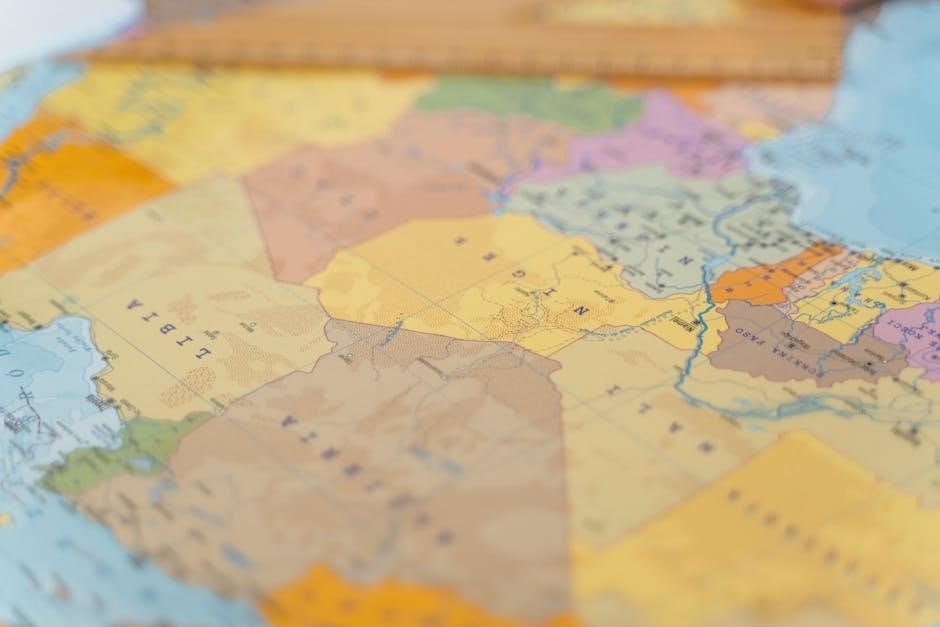Latitude and longitude worksheets provide an engaging way to learn geographic coordinates‚ enhancing map-reading skills and understanding of Earth’s grid system for accurate location identification.
What Are Latitude and Longitude?

Latitude and longitude are coordinates used to pinpoint locations on Earth. Latitude lines run east to west‚ measuring distance north or south of the equator (0°)‚ ranging from 0° to 90°. Longitude lines run north to south‚ measuring east or west of the Prime Meridian (0°)‚ ranging from 0° to 180°. Together‚ they form a grid system essential for mapping and navigation. These coordinates are vital for identifying precise locations‚ aiding in GPS technology‚ and understanding global geography. Worksheets often use these concepts to teach students how to convert coordinates into real-world locations‚ enhancing their spatial awareness and mapping skills effectively.
The Importance of Latitude and Longitude in Geography
Latitude and longitude are fundamental for navigation‚ mapping‚ and understanding Earth’s geography. They provide precise location identification‚ enabling accurate mapping and GPS technology. These coordinates are essential for travel‚ weather forecasting‚ and climate studies‚ as they help determine regional conditions; In education‚ they teach spatial awareness and the Earth’s grid system. Worksheets on latitude and longitude enhance students’ ability to interpret maps and locate continents‚ oceans‚ and cities. This skill is crucial for grasping global geography and applying it in real-world scenarios‚ making latitude and longitude indispensable tools in both academic and practical contexts.
Why Use Worksheets for Learning Latitude and Longitude?
Worksheets are an effective tool for teaching latitude and longitude as they provide structured‚ hands-on practice. They engage students with interactive exercises‚ such as plotting coordinates and identifying locations‚ making learning fun and accessible. Worksheets also reinforce map-reading skills‚ helping students understand how to navigate and interpret geographic data. Additionally‚ they offer customization options to cater to different learning levels and needs. With free‚ printable resources widely available‚ worksheets are a practical and efficient way to enhance geographic knowledge and spatial awareness‚ preparing students for real-world applications of latitude and longitude.

Structure of a Typical Latitude and Longitude Worksheet
A typical worksheet includes maps‚ coordinate grids‚ and questions requiring students to identify locations‚ plot points‚ or match coordinates‚ fostering practical application of geographic skills.
Components of a Latitude and Longitude Worksheet
A typical worksheet includes a map or grid with latitude and longitude lines‚ questions requiring students to identify locations‚ plot points‚ or match coordinates with places. Exercises often involve drawing lines for the equator and prime meridian‚ identifying hemispheres‚ and determining distances between points. Multiple-choice and short-answer questions are common‚ along with tasks like marking specific coordinates or labeling oceans and continents. Some worksheets include answer keys for self-assessment‚ while others provide blank charts for students to create their own maps‚ enhancing hands-on learning and reinforcing geographic concepts effectively.
Types of Questions Included in Worksheets
Latitude and longitude worksheets feature diverse question types to cater to different learning styles. Multiple-choice questions test knowledge of oceans‚ continents‚ and hemispheres. Short-answer and fill-in-the-blank exercises require students to identify coordinates or locations. True/false questions assess understanding of key concepts. Plotting points on maps and matching coordinates with cities or landmarks are common tasks. Some worksheets include labeling exercises‚ where students identify regions based on coordinates. Additionally‚ questions about calculating distances between points or determining the hemisphere of a location are included. These varied question types ensure comprehensive understanding and practical application of latitude and longitude skills.
Examples of Questions Found in Worksheets
Worksheets often include questions like: “In what ocean is the location 10°S latitude‚ 75°E longitude?” or “Identify the continent where 45°N latitude‚ 122°W longitude is found.” Multiple-choice questions‚ such as “Which two continents does the equator cross?” with options like Africa and South America‚ are common. Students may also plot points on maps‚ label hemispheres‚ or match coordinates with cities. True/false questions‚ like “Lines of longitude run north to south‚” test conceptual understanding. These examples help students apply their knowledge of latitude and longitude to real-world geography‚ making learning practical and engaging.

How to Use Latitude and Longitude Worksheets
Start by understanding coordinates‚ then plot points on maps‚ identify locations‚ and answer questions. Use answer keys to verify responses and enhance geography skills effectively.
Understanding Latitude and Longitude Coordinates
Latitude and longitude are Earth’s geographic grid system. Latitude measures distance north or south of the equator (0°)‚ ranging from 0° to 90° in both hemispheres. Longitude measures east or west of the Prime Meridian (0°)‚ spanning from 0° to 180° in both directions. Together‚ these coordinates pinpoint precise locations globally. Understanding these concepts is vital for map reading‚ navigation‚ and identifying regions. Worksheets often include exercises to convert coordinates into real-world locations‚ enhancing spatial awareness and geography skills. This foundation is essential for accurately plotting points and answering questions in latitude and longitude exercises.
Plotting Points on a Map Using Coordinates
Plotting points on a map using latitude and longitude coordinates involves locating the intersection of specific degrees. Start by identifying the equator (0° latitude) and the Prime Meridian (0° longitude). For a coordinate like 40°N‚ 75°W‚ measure 40 degrees north from the equator and 75 degrees west from the Prime Meridian. Use a protractor or straightedge to draw lines if necessary. Ensure the map has clear grid lines for accuracy. Practice with known locations to enhance your skills. This process helps in accurately pinpointing locations on a map using geographic coordinates.
Using Worksheets to Identify Oceans‚ Continents‚ and Cities
Worksheets often include exercises where students use latitude and longitude to identify oceans‚ continents‚ and cities. For example‚ coordinates like 10°S‚ 75°E might locate an ocean. Activities may involve matching coordinates to regions or plotting points on maps. Students learn to recognize patterns‚ such as how specific latitudes correspond to continents. Interactive tasks‚ like matching games or map exercises‚ enhance engagement. These exercises help students connect abstract coordinates to real-world locations‚ improving their understanding of global geography and spatial awareness. Worksheets make learning interactive and fun while reinforcing the practical use of latitude and longitude in identifying key features on Earth.

Benefits of Using Latitude and Longitude Worksheets
Latitude and longitude worksheets enhance geographic knowledge‚ improve map-reading skills‚ and develop problem-solving abilities by engaging students in interactive and practical learning experiences.
Enhancing Geographic Knowledge
Latitude and longitude worksheets are essential tools for enhancing geographic knowledge by teaching students to identify locations using Earth’s grid system. These worksheets help students understand the difference between latitude (horizontal lines) and longitude (vertical lines)‚ enabling them to pinpoint specific places on maps. By answering questions about hemispheres‚ oceans‚ continents‚ and cities based on coordinates‚ students gain a deeper understanding of global geography. Interactive exercises make learning engaging‚ while repetitive practice ensures long-term retention. This skill is crucial for navigation‚ travel‚ and environmental studies‚ providing a strong foundation for future academic and real-world applications.
Improving Map-Reading Skills
Latitude and longitude worksheets are invaluable for improving map-reading skills by teaching students to interpret geographic coordinates effectively. These exercises help learners understand how to locate points on a map using latitude (north-south) and longitude (east-west) lines. By practicing with real-world examples‚ students develop the ability to identify oceans‚ continents‚ and cities based on coordinates. Interactive and printable worksheets provide hands-on experience‚ enhancing spatial awareness and the ability to visualize global relationships. Regular practice with these tools builds confidence and accuracy‚ making maps more accessible and useful for everyday applications.
Developing Problem-Solving Abilities
Latitude and longitude worksheets enhance problem-solving skills by challenging students to analyze and interpret geographic data. Through identifying coordinates‚ plotting points‚ and answering location-based questions‚ learners develop critical thinking and spatial reasoning. These exercises require students to apply mathematical concepts and logical deduction to solve real-world problems‚ such as determining distances or identifying hemispheres. Interactive and printable worksheets further engage students‚ fostering a deeper understanding of how coordinates relate to physical locations. Regular practice with these tools builds confidence and proficiency in tackling complex geographic challenges‚ making problem-solving a natural extension of their learning process.

Where to Find Free Latitude and Longitude Worksheets
Free latitude and longitude worksheets are available on educational websites like Super Teacher Worksheets‚ EasyTeacherWorksheets‚ and Nautical Free‚ offering downloadable PDFs for various grade levels.
Popular Websites Offering Free Worksheets
Super Teacher Worksheets‚ EasyTeacherWorksheets‚ and Nautical Free are top destinations for free latitude and longitude worksheets. These websites offer a variety of printable and interactive resources‚ including PDFs‚ designed for different grade levels. Many provide customizable options‚ allowing teachers to tailor content to specific learning needs. Additionally‚ they often include answer keys and solutions‚ making them ideal for self-assessment and classroom use. These platforms are widely used by educators and students for enhancing geographic knowledge and map-reading skills. They cater to diverse educational requirements‚ ensuring accessible and engaging learning experiences for all.
How to Download and Print Worksheets
To download and print latitude and longitude worksheets‚ visit websites like Super Teacher Worksheets or EasyTeacherWorksheets. Browse their collections‚ select the desired PDF worksheet‚ and click the download button. Once downloaded‚ open the file using a PDF reader and print it using your printer. Ensure your printer is set to the correct paper size and orientation for optimal results. Many websites also provide answer keys‚ which can be downloaded separately for convenience. This straightforward process allows teachers and students to access high-quality educational resources quickly and efficiently. Always check for the latest updates to ensure you have the most current versions available.
Customizing Worksheets for Specific Needs
Customizing latitude and longitude worksheets allows educators to tailor activities to specific grade levels or learning objectives. Use online tools to generate worksheets with particular coordinates or regions. Modify question types‚ such as adding more map-plotting exercises or location identification tasks. Adjust difficulty levels by selecting simpler or more complex coordinates. Incorporate local landmarks or cities to make learning relevant. Ensure alignment with curriculum standards by focusing on key skills like hemispheric identification or calculating distances. Customization enhances engagement and ensures worksheets meet the diverse needs of students‚ making learning more effective and enjoyable.

Interactive and Printable Worksheets
Interactive worksheets offer engaging exercises like clickable maps and quizzes‚ while printable versions provide traditional practice. Both formats enhance learning by catering to different student preferences and learning styles effectively.
Features of Interactive Worksheets
Interactive latitude and longitude worksheets offer dynamic learning experiences with clickable maps‚ real-time feedback‚ and quizzes. They include draggable markers‚ coordinate generators‚ and interactive exercises that make learning engaging. Students can plot points‚ identify locations‚ and test their knowledge through gamified activities. Many worksheets feature customizable templates‚ allowing teachers to tailor exercises to specific lessons. Interactive tools also provide immediate corrections‚ helping students learn from mistakes. These features make complex concepts like hemispheres and time zones more accessible and fun‚ ensuring a deeper understanding of geographic coordinates in an immersive way.
Advantages of Printable Worksheets
Printable latitude and longitude worksheets offer flexibility and convenience for teachers and students. They can be easily downloaded‚ customized‚ and used offline‚ making them ideal for classrooms with limited technology. Printable worksheets provide a tactile learning experience‚ allowing students to practice plotting coordinates and identifying locations manually. Many worksheets are available in PDF format‚ ensuring high-quality printing and consistent results. They also enable self-paced learning‚ giving students the freedom to review and practice concepts independently. Additionally‚ printable worksheets are often free‚ making them an accessible resource for educators and learners worldwide to enhance geography skills effectively.
Using Online Tools to Generate Worksheets
Online tools simplify creating custom latitude and longitude worksheets‚ allowing educators to tailor content to specific lessons or student needs. Teachers can input coordinates‚ questions‚ or maps to generate exercises that align with curriculum goals. These tools often feature templates‚ interactive elements‚ and the ability to import maps‚ enhancing engagement. They save time by automating worksheet creation and provide diverse scenarios for practice. Customization options enable teachers to incorporate relevant cities or landmarks‚ making learning more effective. Additionally‚ online tools offer convenience‚ allowing quick generation and sharing of materials‚ thus empowering educators to create dynamic‚ personalized learning resources efficiently.

Real-World Applications of Latitude and Longitude
Latitude and longitude are essential for navigation‚ travel‚ and mapping technologies‚ helping determine precise locations for GPS systems‚ weather forecasting‚ and geographic information systems (GIS).
Navigation and Travel
Latitude and longitude are crucial for navigation and travel‚ enabling precise location identification. GPS systems rely on these coordinates to guide users accurately. Worksheets help students understand how to plot points‚ draw lines like the equator and prime meridian‚ and identify oceans or continents. Activities include marking specific locations‚ such as 10°S‚ 75°E‚ and determining the corresponding ocean. These skills are vital for real-world applications‚ such as planning trips or understanding global geography. By mastering latitude and longitude‚ students gain essential tools for navigation‚ enhancing their ability to explore and map the world effectively.
Weather Forecasting and Climate Study
Latitude and longitude play a vital role in weather forecasting and climate study by enabling precise location tracking of weather patterns. Meteorologists use these coordinates to monitor storms‚ hurricanes‚ and climate trends. Worksheets help students understand how to map weather systems and analyze data based on geographic locations. For example‚ plotting points like 10°S‚ 75°E‚ can help identify weather patterns in specific regions. This skill enhances climate modeling and prediction accuracy‚ making it essential for environmental science and global weather monitoring systems. Interactive exercises in worksheets make learning engaging and applicable to real-world climate and weather scenarios.
GIS and Mapping Technology
GIS (Geographic Information Systems) relies heavily on latitude and longitude to map and analyze spatial data. Worksheets help students understand how to apply coordinates in GIS software‚ enabling precise location identification and data visualization. By plotting points like 33°N‚ 112°W‚ users can practice geocoding and spatial analysis. These skills are essential for urban planning‚ environmental studies‚ and logistics. Interactive exercises in worksheets enhance proficiency in mapping technologies‚ allowing users to overlay data on maps and perform advanced analyses. This integration of latitude and longitude with GIS tools fosters a deeper understanding of geographic data and its real-world applications.

Answer Keys and Solutions
Answer keys provide correct solutions for latitude and longitude worksheets‚ ensuring accuracy and understanding. They help verify responses‚ identify mistakes‚ and reinforce learning effectively.
Importance of Answer Keys for Worksheets
Answer keys are vital for assessing student progress and understanding in latitude and longitude exercises. They provide clear‚ correct solutions‚ enabling self-assessment and immediate feedback. By comparing their answers with the keys‚ students can identify errors‚ reinforcing their grasp of geographic coordinates. Teachers also benefit‚ as keys streamline grading and ensure consistency. This resource fosters accountability‚ accuracy‚ and confidence‚ making it an essential tool for effective learning and teaching of latitude and longitude concepts in educational settings.
How to Create Effective Answer Keys
To create effective answer keys for latitude and longitude worksheets‚ ensure accuracy by cross-referencing coordinates with reliable maps or digital tools. Organize answers logically‚ matching the worksheet’s structure for easy reference. Provide clear explanations for complex questions‚ especially when multiple steps are involved; Use bold or color-coded text to highlight correct answers‚ enhancing readability. Include page numbers or question identifiers to avoid confusion. Finally‚ review and update answer keys periodically to reflect any changes in geographic data or teaching standards‚ ensuring they remain relevant and precise for student learning and assessment.
Using Answer Keys for Self-Assessment
Answer keys for latitude and longitude worksheets enable students to independently verify their work‚ fostering self-assessment and accountability. By comparing their responses to the correct answers‚ learners can identify mistakes‚ understand errors‚ and reinforce their understanding of geographic coordinates. This self-assessment process encourages critical thinking and problem-solving skills‚ allowing students to address gaps in knowledge without teacher intervention. Regular use of answer keys helps build confidence and accuracy in reading maps and interpreting latitude and longitude‚ making it an essential tool for effective learning and skill development in geography.

Difficulties and Challenges
Students often struggle with accurately plotting coordinates and understanding hemispheres‚ leading to common mistakes like misidentifying directions or confusing latitude and longitude lines.
Common Mistakes When Using Worksheets
Common mistakes include confusion between latitude and longitude‚ misidentifying hemispheres‚ and mislabeling directions (e.g.‚ east as west). Students often struggle with accurately plotting points on maps‚ leading to incorrect location identifications. Additionally‚ some learners may incorrectly interpret degrees or fail to recognize the Prime Meridian and equator as reference points. These errors highlight the importance of clear instructions and practice to master geographic coordinates effectively.
Strategies to Overcome Learning Difficulties
To overcome challenges‚ break down concepts into smaller parts‚ starting with understanding latitude and longitude basics. Use visual aids like maps and globes to reinforce learning. Encourage interactive practice with online tools and apps that simulate coordinate plotting. Provide step-by-step instructions and examples to clarify confusing points. Offer one-on-one support for students struggling with spatial awareness or directional concepts. Incorporate real-world applications‚ such as identifying cities or landmarks‚ to make learning relatable. Regularly review and practice with worksheets to build confidence and accuracy in using geographic coordinates effectively.
Best Practices for Effective Learning
Integrate multiple teaching methods to enhance understanding of latitude and longitude. Begin with clear explanations of concepts‚ supported by visual aids like maps and globes. Encourage active participation through interactive tools and real-world applications. Use collaborative learning strategies‚ such as group activities‚ to foster engagement. Provide immediate feedback and assessment to track progress. Incorporate technology‚ like online worksheets and apps‚ to offer personalized practice. Reinforce concepts regularly to build long-term retention. Create a structured learning environment that promotes curiosity and critical thinking‚ ensuring students grasp the practical relevance of geographic coordinates in everyday life.
Latitude and longitude worksheets are a valuable tool for mastering geographic coordinates‚ enhancing map-reading skills‚ and fostering a deeper understanding of Earth’s spatial organization through interactive learning.
Latitude and longitude worksheets are essential tools for teaching geographic coordinate systems‚ helping students identify locations‚ understand map-reading‚ and enhance spatial awareness. They provide interactive and printable exercises‚ covering topics like oceans‚ continents‚ and cities. These worksheets improve problem-solving skills and offer real-world applications in navigation and technology. With answer keys for assessment‚ they cater to diverse learning needs‚ making them invaluable for educators and students alike. Free resources are widely available online‚ ensuring accessibility for all. Regular practice with these worksheets fosters a deeper understanding of Earth’s geography and its complex systems.
Encouragement to Use Worksheets for Learning
Embrace latitude and longitude worksheets as a dynamic tool to enhance geographic literacy and critical thinking. These resources engage students through interactive exercises‚ making complex concepts accessible and fun. By practicing with worksheets‚ learners develop essential map-reading skills and a deeper understanding of Earth’s coordinate system. Teachers can customize activities to suit diverse needs‚ while students benefit from clear structures and answer keys for self-assessment. Whether printed or digital‚ these worksheets offer a practical and enjoyable way to explore geography‚ fostering curiosity and confidence in young minds. Make them a cornerstone of your learning journey for a stronger grasp of our world’s layout and connections.

